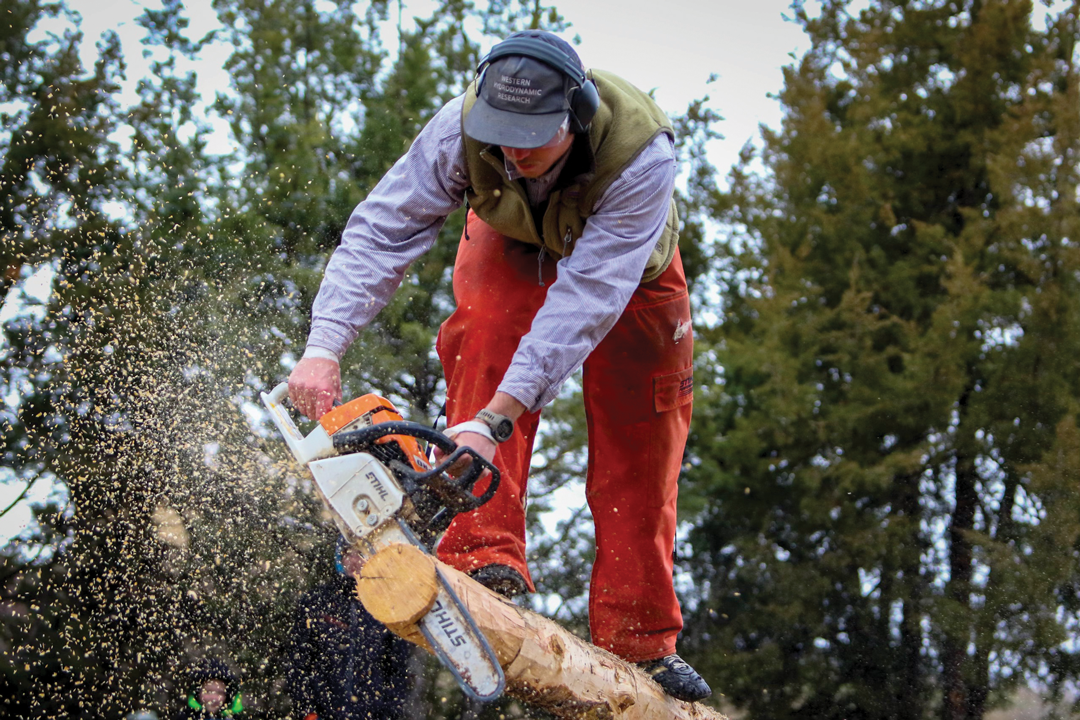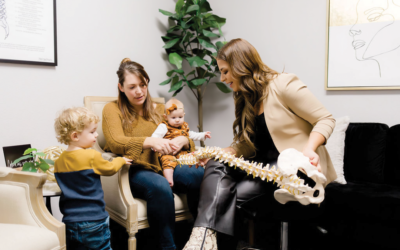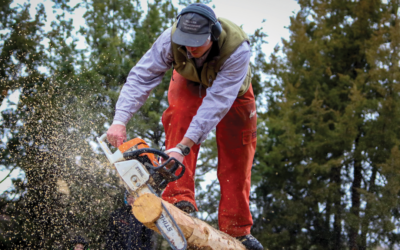There’s a shed tucked in the back corner of the Factory, a place on Colorado State University’s Foothills Campus that appears remote enough to be a good place to hang out when the zombies attack.
It’s easy to find the shed. Just look for the hundreds of logs, some the size of tree stumps, piled together in preparation for what could be the world’s biggest bonfire. Walk south, and you might find Chris Graham and Joey Long, both CSU students, eagerly waiting to give you a tour of their practice field and, of course, the contents of the shed.
They open the shed with glee, the kind you’d expect from a suburban dad addicted to yard work. Sure enough, it’s full of axes, chainsaws, handsaws and other intense forest equipment you’d either find in Paul Bunyan’s closest or on the set of a slasher movie.
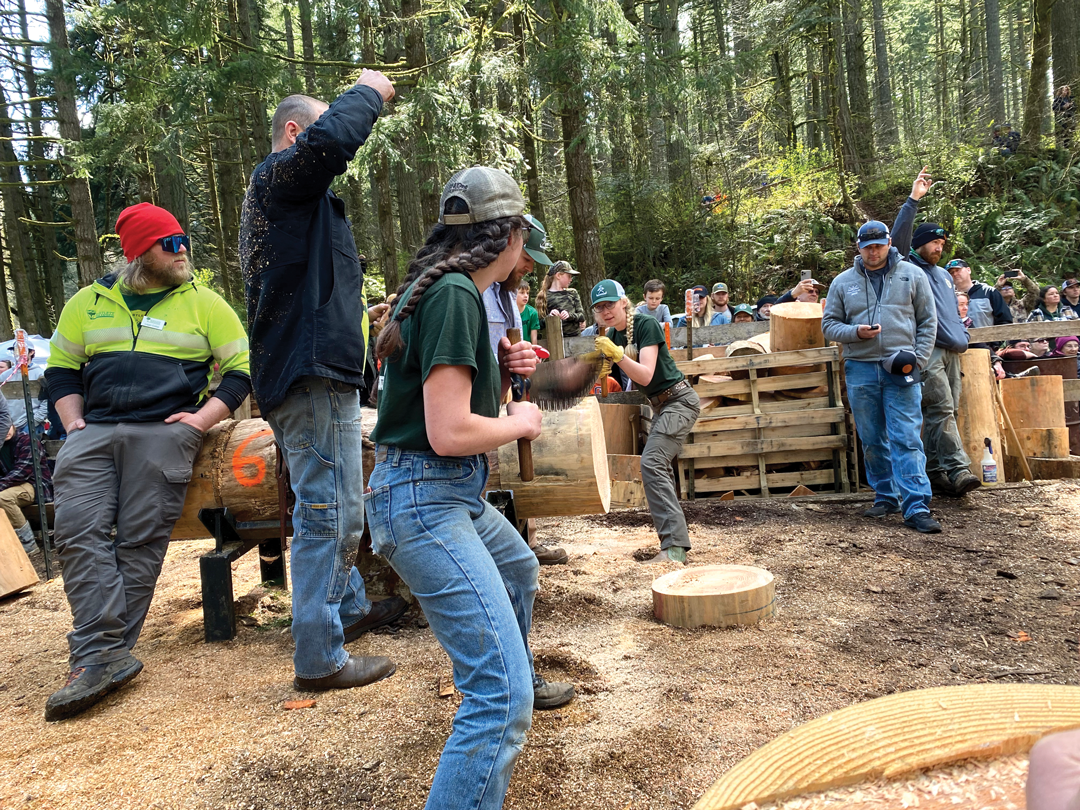
Maya Van Dyke (left) and Maggie Pringle (right) do a “double buck,” a two-person sawing competition.
This shed isn’t where CSU keeps tools for its tree maintenance division. It’s where Graham, Long and the rest of the CSU logging sports team essentially keep their gym equipment. The pile of logs, bullseye targets and yard scattered with so many wood chips that grass has forgotten how to grow is, basically, a CrossFit center.
Graham and Long are officers for the team. The sport measures competitors’ ability to chop, saw and climb logs, and some competitions involve running with chainsaws and throwing axes. This is why competitors wear chainmail socks and moon boots covered in hard steel and use many of the same tools old-school lumberjacks would use.
“A lot of the best aren’t blessed with true athleticism,” Graham says. “It’s a very skill-based sport.”
CSU’s logging sports club is as little known as the location of its practice field, but both the sport and the club have a long history. The CSU Forestry Club was formed in 1925, and the first logging competition took place in 1953. After a hiatus, the sport made a comeback in the mid-80s. When the club reformed, they found some of the old logging equipment, unused, in the basement of CSU’s forestry office. The large handsaws currently stowed in the CSU shed, many of them bigger than a person, are nearly 100 years old.
Even if it’s not an NCAA sport, logging appears to be doing well as a niche. There are even professional competitions.
Women compete as well as men and hold their own, sometimes in head-to-head competitions and other times in mixed events or their own divisions. Half of the CSU logging club members are women, Graham says, and they have nearly 40 members total. In April 2025, CSU will host the American Western Forestry Clubs Conclave, a regional competition that can attract more than a couple hundred students to chop wood.
“You get to know all the other competitors, so a Conclave is a really cool reunion,” Long says.

CSU’s Forestry Day in the 1960s. Photo courtesy of the CSU Library Archives.
CSU’s logging sports team is a club, meaning the university offers a little support but no scholarships, recruiting or staff to coach members. The club is run by students such as Graham and Long, who raise money by selling firewood and have built relationships with Stihl, the chainsaw giant that donates equipment.
Since competitions involve pole climbing, sawing, chopping and axe throwing, bad things can happen. However, the most common injuries occur when competitors’ hands get torn up. That happens to everyone at first.
“Everyone bleeds the first month or so,” Long says.
Will chop for money
Adrian Flygt, a high school teacher in Fort Collins, found a little fame in the sport, not only by competing but also by announcing for ESPN. Flygt looks exactly how you’d expect a lumberjack to look: He’s 6-foot-4 and “every bit” of 275 pounds, he says, with the voice and beard to match. But he has the brain of Socrates, and that brain, not the brawn, is why he got into logging sports during his time at CSU.
He was studying too much, and it just so happened that he also loved tools—he once owned 46 axes—as well as being outside. Once he learned about the history of logging sports, the romantic philosopher in him was hooked.
“I needed some balance,” he says. “It was a good complement to the library, all the reading and writing and studying I was doing. I loved learning about the fine secrets of a historical sport and perfecting them. The thing with woodchopping is you can’t fake it; it takes time and blisters and calluses.”
In 2008, at age 27, Flygt won the regional Western title at the Conclave. He started teaching physics at Rocky Mountain High School in 2010 and became a leader in logging sports as well. He qualified for the top league, the Stihl Timbersports Series, three times and even hosted his own show on logging sports. One year, he drove 25,000 miles just to go to meets, he says.
Another logging legend, Steve Meyer, started competing in 1989 while at CSU. He loved playing lacrosse, hockey and soccer and considered it just another sport until he started competing and became hooked. The club was even more bare bones back then.
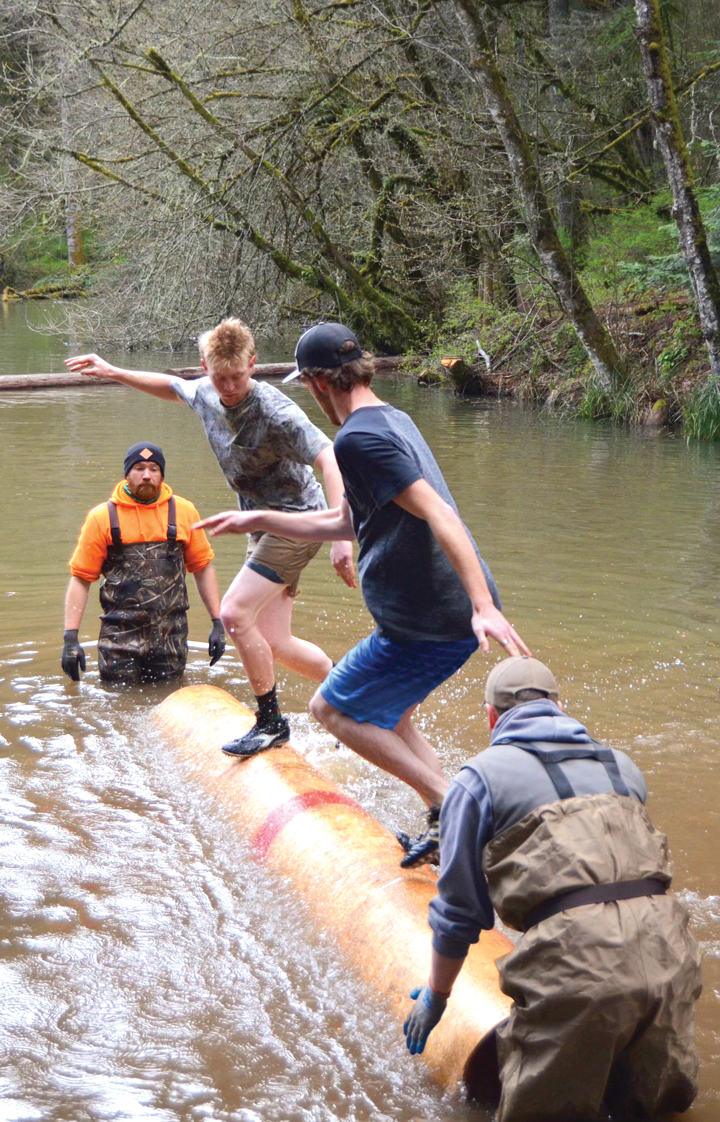
Ethan Arnette of Colorado State University (right) competes in a log roll against Jack Love from Northern Arizona University (left) in a 2023 Conclave competition.
“We’d cut logs from the Colorado State Forest and bring them back down to campus,” he says.
Meyer enjoyed the sport so much that he even competed on weekends. He has many fond memories: One of his favorite events was over Labor Day at Cripple Creek during a snowstorm.
“Frankly, there were only so many of us doing it that the shows were structured where everyone could come home with a little money,” Meyer says. “You could make decent money on the weekends.”
Flygt competed for the camaraderie as much as the cash, he says. Many would offer up their homes so he and his dog, Aretha, had a place to stay during competitions. He appeared in many fellow competitors’ weddings.
“It’s a very cool community,” he says. “You see people lifting each other up.”
This is true for women too, says Haley Modin, a 2019 CSU graduate who lives in Loveland. She took on a forestry work crew for a summer job and liked “playing with chainsaws,” especially the hard manual labor of it. She was one of two women on the logging team, and she felt welcomed by most competitors.
Modin now occasionally competes with the Axe Women Loggers of Maine, a nationwide organization of female logging athletes that puts on exhibitions at shows such as the Colorado State Fair.
“It’s a super cool organization of badass women,” Modin says. “It’s cool to see the sport change and grow and see some women show up and clean house. It’s my favorite thing. I enjoy it so much.”
Real-life work experience
Woodchopping was good to Flygt, but he worries about the sport’s future. There are really only three ways to get into it, he says. Either your family is into it, you work it as a summer job (like Modin did) or you find it in college.
“The thing I really worry about is college is so expensive now that people are concerned with getting out as fast as possible,” Flygt says. “They can’t afford to dawdle.”
He admits he dawdled a bit by joining the team, but it would end up earning him some fame, fun and extra money, plus his identity as a lumberjack, a title he wears proudly years after his last competition. Meyer, who also lives in Fort Collins, found a career building log homes and currently works as a timber framer for Elevated Design Build.
“It wound up critical to my entire career path,” Meyer says.
The chainsaws and other sharp equipment give competitors experience and preparation for a job.
“It’s practical forestry experience,” Graham says. “That’s rare. They learn more than what they’re taught in the classroom. There’s no other opportunity like it in other clubs at CSU.”
Long and Graham have big plans for their future. Both will get a degree in landscaping, and they hope to open their own business, something that will leave them a little time for fun.
“We hope to compete as long as we can,” Long says.
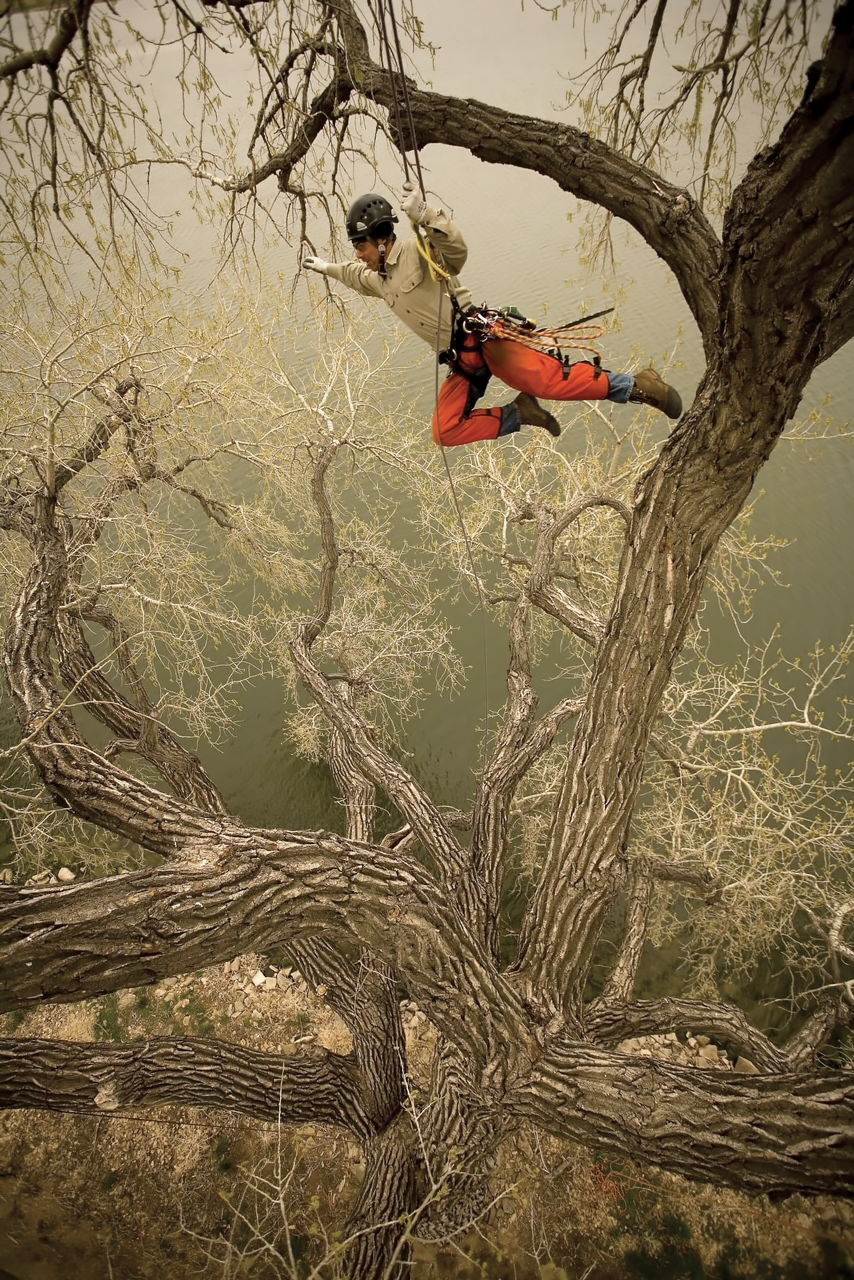
Luke Glines
Competitive Tree Climbing
Luke Glines climbs trees for his job. Then, at night, after dinner, he climbs trees for fun.
Glines is the owner of Luke Glines Tree Experts in rural Greeley. He’s an arborist, but he’s also spent many years climbing trees in the International Tree Climbing Championships. At age 56, he still competes.
“The judges are my age,” Glines says, “and they really resent the fact that I’m still doing well and they can barely get up a tree anymore.”
Glines is good at it, too: He finished second in the North American Tree Climbing Championship twice and eighth in the world once. He’s won the Rocky Mountain Chapter Tree Climbing Championship title a whopping 14 times. Two years ago, he competed in the world championships in Copenhagen.
“It’s not as popular here, but it’s huge in Europe,” he says. “I was surprised at how many were cheering. It was like a big fair.”
Glines was a competitive runner in his 30s and an arborist before he met someone at a tree conference who suggested he give climbing a try. He never looked back. He now has four trees on his property and plenty of ropes and gear on them, so he can hop in his own wooden gymnasium anytime he likes.
“It’s a sport that has everything to do with my profession,” he says. “That’s how I got into it.”


